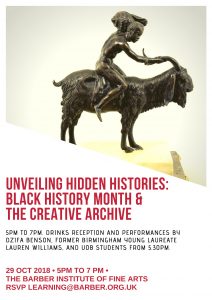
At around 5pm, we gathered together in the Barber Institute of Fine Art for an evening of poetry reading, written and performed by students of the university during a workshop run by celebrated artist Dzifa Benson. The workshop ran earlier that October with the aim of drawing out and interrogating the histories of people of colour within the paintings, artefacts, and sculptures held at the Barber Institute – histories that have been continually elided by an overly whitewashed tradition of art criticism, exhibition, and consumption. The poetry was to be read alongside its corresponding piece as part of a tour through the gallery space in order to emphasise more directly the presence of people of colour within art, and to examine the discrepancies between their representation on the one hand and their actual involvement in history on the other. The hope was to read against a conventional white Western self-conceptualisation, to which fine art is so often the visual accompaniment, that could rehabilitate ideas of our own national, cultural, and racial histories.


After the introduction of the event, and before we began the tour itself, we were treated to a selection of readings by former Birmingham Young Laureate Lauren Williams, who read three of her own works reflecting on the experience of being a young black woman in the Midlands.
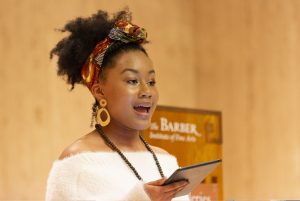
Next, we moved into the gallery, congregating around each picture, one by one, to listen to the corresponding readings by the students. First was Charlotte Igharo, reading her poem ‘Whitewashed’, in front of Cosimo Rosselli’s The Adoration of Christ (1485), in which she picks up on the representation of religious figures as uniformly white and, therefore, on the erasure of people of colour from Biblical knowledge and religious heritage that we see in so much Christian interpretation in our galleries and museums.

Following on from this, we proceeded to Jan Steen’s The Wrath of Ahasuerus (1668-70), depicting King Ahasuerus’s anger at his chief minister Haman whose plot to massacre the Persian Jews has just been exposed by the King’s wife, Esther. Here we heard two poems. First, was Megan Reddy reading ‘Esther’s Wrath’, which refocuses the attention away from the men and on to the emotions of the Jewish Esther who experiences her own unique anger which shares in some aspects of her husband’s wrath – anger as the betrayed – but also involves the feelings of being a direct target of genocidal ambition. Afterwards, Anya Aujla-Jones read ‘Is the Bermuda Triangle a hole in the sea?’, which is inspired by the two black figures merged into the background of the painting who are given less visibility than even the animals. She links this expurgatory painting technique to the tea set on the table, central to the image, to construct an image of the Atlantic slave trade and the violent cultivation of tea plantations by colonialism.

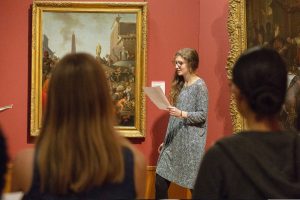
We then heard ‘Chinese Whispers’ by Kirmjeet Kaur Ghag in front of The Marriage at Cana (1672) by Bartolome Esteban Murillo, a work inspired by the black boy central to the painting yet overlooked by the surrounding figures and left out of the celebrations. Bethan Fairhurst then read out her piece relating to a gold teapot and stand from 1785, the opulence of which masks the history of exploitation and colonialism behind not only the precious metals from which it was made, but also at the heart of the troubling heritage of tea in Britain, reading it as a subliminal glorification of violence and racism.
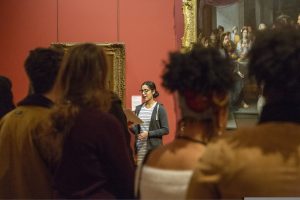

The final reading in the gallery was from Dzifa Benson, who was inspired by Andrea Riccio’s sculpture African Boy Riding a Billy-goat (1500s), and produced a poem examining the sexualised representation of black men, and the hyper-virility hinted at by the bacchanalian associations of the goat, and by the largeness of the conch shell carried by the figure. Around the gallery, there were additional poems that were not included in the readings: also beside the Riccio statuette was a piece by Sana Haq, which looked at how the medium of sculpture can work to fuse the figures in the piece into a single entity – an artwork – to create dehumanising and racist parallels and associations. Elsewhere, complementing Peter Anton Verschaffelt’s A Rhinoceros, called Miss Clara (1750) was a work by Sabeeha Zahieer, which examines the cruelty of commodifying and exhibiting living bodies within the marketing of the ‘exotic’ to white Western audiences.
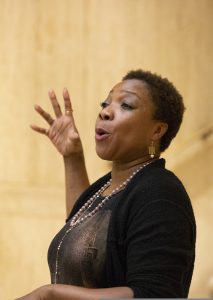
Finally, we returned to the Barber foyer to hear an engaging and vibrant reading by Benson of her poem ‘Bottom Power’, inspired by the cruel and racist treatment of the South African Khoikhoi woman Sara Baartman by Dutch colonists, who exhibited her at a freak show on account of her large buttocks. Benson’s reading, whilst looking back through black history, maintained a relation to the present-day experience of being black and the way in which the bodies of black women are treated, discussed, commodified, ridiculed, represented, and appropriated in the West, even 200 years after Baartman’s death. Additionally, our attention was drawn to the influence that her uniquely famed case had on the development of civil rights in the United Kingdom, and how these developments might inform our discourse about women’s bodies as we move forward, ending a critically and creatively productive event, both entertaining but also important to our reappraisal of Western art and of the cultural and historical narratives that conceal many of the black histories integral to their existence.

All credit and thanks goes to Victoria Beddoes for these brilliant photographs.

Twitter: @CCLC_bham
Website: https://bit.ly/2DWj1Qg
To join the CCLC maling list please email: r.sykes@bham.ac.uk
